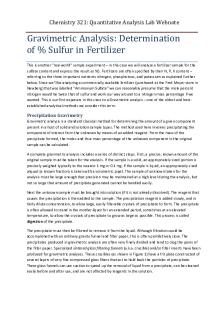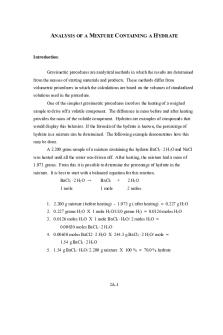Lab 4 Gravimetric Analysis of Chloride PDF

| Title | Lab 4 Gravimetric Analysis of Chloride |
|---|---|
| Course | Comprehensive General Chemistry |
| Institution | University of Chicago |
| Pages | 3 |
| File Size | 109.9 KB |
| File Type | |
| Total Downloads | 23 |
| Total Views | 143 |
Summary
Fourth Lab...
Description
Gravimetric Analysis of Chloride: Lab 4 Name: Xavier Valencia Lab Partner: Trinity Campagna Jessice Goigon Section: 2A38 11/9/2018 Introduction: Gravimetric analysis is a technique designed to isolate and determine the measurement of mass of the ion. By separating and determining that mass of the ion in the solution we can determine the molar mass and the other molecule used in the compound (MxCly). Through gravimetric analysis the values of M, x, and y can be determined. Typical gravimetric analysis has chemists weight the sample of the unknown substance, dissolve the sample in a solvent, add a regent to form a precipitate, filter and dry the precipitate and calculate the percent of substance from the weight of the precipitate and the sample. For example, in this experiment the unknown compound of Cl- is added to water, to ionize. Then mixed with both HNO3 and AgNO3, which forms a precipitate through the reaction in Figure 1.A. After the precipitate is formed it is filtered and dried in a drying oven, after the final mass of AgCl is determined and used in the calculations to determine the mass of the compound M. Figure 1.A Ag + Cl- → AgCl(s) +
Experimental: Procedure: (found in Green Lab Manual Zhao, General Chemistry Lab Manual (1st Edition), pgs. 36-38) Original Procedure: No Altered Procedure Data Analysis: Gravimetric Analysis Data Collection
Trial 1:
Trial 1
Trial 2
Mass of Cl- sample:
0.2511 g
0.2500 g
Mass of crucible:
32.2227 g
32.1936 g
Mass of crucible + precipitate:
32.8383 g
32.7750 g
Mass of AgCl precipitate:
0.6156 g
0.5814 g
Trial 2:
mol AgCl = (g AgCl / g/mol AgCl) mol AgCl = (0.6156 g / 143.323 g/mol AgCl) mol AgCl = 4.295 x 10-3 mol
mol AgCl = (g AgCl / g/mol AgCl) mol AgCl = (0.5814 g / 143.323 g/mol AgCl) mol AgCl = 4.057 x 10-3 mol
g Cl- = (mol AgCl) * (g/mol Cl-) g Cl- = (4.295 x 10-3 mol) * (35.342 g/mol Cl-) g Cl- = 0.1518 g
g Cl- = (mol AgCl) * (g/mol Cl-) g Cl- = (4.057 x 10-3 mol) * (35.342 g/mol Cl-) g Cl- = 0.1434 g
% Cl- = g Cl- / g sample % Cl- = 0.1518 g Cl- / 0.2511 g % Cl- = 0.6045 x 100% % Cl- = 60.45%
% Cl- = g Cl- / g sample % Cl- = 0.1434g / 0.2500 g % Cl- = 0.4300 x 100% % Cl- = 57.36%
Trial Averages: Av. % Cl- = (Trial 1 + Trial 2) / 2 Av. % Cl- = (60.45 + 57.36) / 2 Av. % Cl- = (117.81) / 2 Av. % Cl- = 58.91% Chemical Formula Calculation: m of unknown compound: 35.342 g Cl- * (0.4109 g ? / 0.5891 g Cl-) m of unknown compound: 24.65 g/mol (Na = 22.99 g/mol) ≈ 24.65 g/mol Predicted Chemical Formula: NaCl Discussion: The results determined experimentally has the mass of the unknown molecule as 24.65 g/mol. If we were to analyze this figure and simply point at the element closest to this mass we would determine that MgCl was the sample given. However, MgCl doesn’t exist. As the only compound with only Mg and Cl is the Magnesium Chloride compound (MgCl2), which isn’t possible as the percent of Chloride by weight would be very different. The next logical option is the salt Na+, at 22.9898 g/mol. The ideal percent by mass of Cl- would be 60.66%, as determined by the elemental weight of Cl divided by the the mass of NaCl. In the experiment the calculated average Cl- percent is 58.91%, lower than the expected. Meaning that while conducting the experiment some AgCl precipitate must have been left in the beaker while filtering, or the mixing of AgNO3 and NaCl didn’t go to completion, not allowing all the possible AgCl to form. A way to fix the incomplete reaction of AgNO3 and NaCl would be to allow to the reaction go for a longer duration as well as trying to limit light exposure from breaking down the light sensitive silver chloride. Post Lab Discussion: 1a. Gravimetric analysis isn’t to determine trace amounts of ions due to the small mass of
the trace ions, making it difficult to get accurate calculations. Gravimetric analysis depends on the ability to weigh the sample before and after the precipitate, something trace ions make difficult and inaccurate. b. (in discussion sections) 2. mol AgCl = (g AgCl / g/mol AgCl) mol AgCl = (0.523 g / 143.323 g/mol AgCl) mol AgCl = 3.65 x 10-3 mol g Cl- = (mol AgCl) * (g/mol Cl-) g Cl- = (3.65 x 10-3 mol) * (35.342 g/mol Cl-) g Cl- = 0.128 g % Cl- = (g Cl- / g sample) x 100% % Cl- = (0.128 g Cl- / 0.323 g) x 100% % Cl- = 39.9% x = 1, y = 1 Theoretical molar weight: 35.342 g Cl- * (0.323 g ? / 0.399 g Cl-) Theoretical molar weight: 28.6 g/mol x = 1, y = 2 Theoretical molar weight: 70.634 g Cl2 * (0.323 g ? / 0.399 g Cl2) Theoretical molar weight: 57.2 g/mol x = 2, y = 4 Theoretical molar weight: 141.27 g Cl4 * (0.323 g ? / 0.399 g Cl4) Theoretical molar weight: 114.3 g / 2 mol M Theoretical molar weight: 57.2 g/mol Conclusion: Our experimental mass of the unknown element in the Cl- sample was calculated to be 24.65g/mol. After deducing that the closest element, Magnesium, isn’t a viable option as a compound MgCl, the final compound NaCl was derived. Our experimental value (24.65g/mol), when compared to the actual mass of Na (22.99g/mol) results in a percent error of 7.22% (Calculation 1.A). There is little to no improvements outside of the ones mentioned in the discussion. The low experimental error derives from good procedure and experimental values, closer attention to collecting all the AgCl could account for the error, aside from that no improvements are needed. Calculation 1.A ((24.65 g/mol - 22.99 g/mol) / 22.99 g/mol) = 7.22%...
Similar Free PDFs

Synthesis of tert-Butyl Chloride
- 6 Pages
Popular Institutions
- Tinajero National High School - Annex
- Politeknik Caltex Riau
- Yokohama City University
- SGT University
- University of Al-Qadisiyah
- Divine Word College of Vigan
- Techniek College Rotterdam
- Universidade de Santiago
- Universiti Teknologi MARA Cawangan Johor Kampus Pasir Gudang
- Poltekkes Kemenkes Yogyakarta
- Baguio City National High School
- Colegio san marcos
- preparatoria uno
- Centro de Bachillerato Tecnológico Industrial y de Servicios No. 107
- Dalian Maritime University
- Quang Trung Secondary School
- Colegio Tecnológico en Informática
- Corporación Regional de Educación Superior
- Grupo CEDVA
- Dar Al Uloom University
- Centro de Estudios Preuniversitarios de la Universidad Nacional de Ingeniería
- 上智大学
- Aakash International School, Nuna Majara
- San Felipe Neri Catholic School
- Kang Chiao International School - New Taipei City
- Misamis Occidental National High School
- Institución Educativa Escuela Normal Juan Ladrilleros
- Kolehiyo ng Pantukan
- Batanes State College
- Instituto Continental
- Sekolah Menengah Kejuruan Kesehatan Kaltara (Tarakan)
- Colegio de La Inmaculada Concepcion - Cebu














